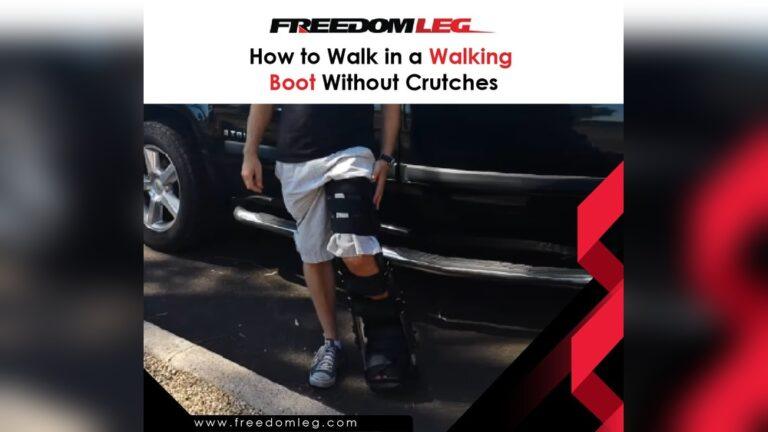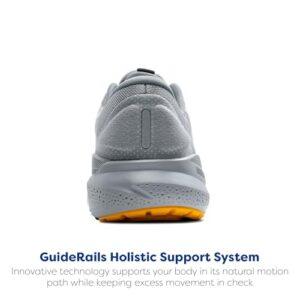If you’re wearing a walking boot and wondering how to ditch the crutches safely, you’re not alone. Using crutches can be tiring and limit your mobility, but walking without them too soon might slow your healing or cause pain.
The good news? With the right approach, you can regain your freedom step by step. You’ll discover simple, practical tips to help you walk confidently in your walking boot without crutches. From mastering proper posture to knowing when and how to make the transition, you’ll learn exactly what your body needs to heal while moving with ease.
Ready to take control of your recovery? Keep reading to find out how to walk in your walking boot without crutches—safely and smoothly.
When To Stop Using Crutches
Knowing when to stop using crutches is important for safe recovery. Removing crutches too soon can cause pain or injury. Pay close attention to your body and follow expert advice. This helps ensure a smooth transition to walking with just your boot.
Signs You’re Ready
Feeling little or no pain when putting weight on your foot is a good sign. You should be able to stand and balance without support. Walking short distances without limping shows improvement. Swelling and soreness should be minimal or gone. Your walking boot should feel stable and comfortable.
Doctor’s Clearance
Your doctor must check your progress before you stop using crutches. They will assess healing through exams or scans. The doctor will confirm if your bones or tissues are strong enough. Follow their instructions carefully to avoid setbacks. Getting their approval reduces the risk of injury.

Credit: getaboutmobility.com.au
Preparing To Walk Without Crutches
Preparing to walk without crutches requires careful planning and practice. Your body needs time to adjust to the new way of moving. This phase helps build confidence and strength. It also reduces the risk of injury or setbacks.
Start by ensuring your walking boot fits well and feels comfortable. Next, work on simple exercises that improve your leg muscles. These steps prepare your body to support your weight steadily. They also promote balance and stability.
Adjusting The Walking Boot
Check the straps of your walking boot first. They should be snug but not too tight. Too tight straps can reduce blood flow and cause discomfort. Too loose straps may cause instability while walking.
Make sure the sole of the boot touches the ground evenly. Uneven contact can affect your balance. Adjust the boot height if possible, so it matches the other foot comfortably. A well-fitted boot supports your foot and ankle properly.
Wear the boot with the right type of sock. Thick socks can help reduce friction and prevent blisters. Always follow your doctor’s instructions about wearing and adjusting the boot.
Strengthening Exercises
Begin with simple exercises to strengthen your leg muscles. Sit down and lift your foot up and down slowly. This movement helps increase ankle strength without strain.
Try gentle toe curls by scrunching your toes inside the boot. This exercise improves foot flexibility. Also, practice lifting your heel while keeping your toes on the ground. It builds calf muscle strength.
Balance exercises are important too. Stand near a wall or chair for support. Shift your weight slowly from one foot to the other. This practice enhances stability and coordination.
Do these exercises daily but stop if you feel pain. Consistency helps your muscles grow stronger for walking without crutches.
Walking Techniques In A Boot
Walking in a walking boot without crutches requires specific techniques to ensure safety and comfort. Proper walking helps avoid extra strain and supports healing. Focus on controlled movements and body alignment for better balance.
Heel-to-toe Motion
Start by placing your heel on the ground first. Roll your foot forward, shifting weight from heel to toe. This motion mimics natural walking and reduces pressure on injured areas. Take slow, steady steps to maintain control.
Using The Rocker Bottom
The rocker bottom of the boot helps smooth your steps. It allows your foot to roll forward easily without lifting too much effort. Use this design to support your stride and keep your balance steady. Let the boot guide your foot’s natural motion.
Foot Positioning
Keep your foot straight ahead while walking. Avoid turning it outward or inward, which may cause discomfort. Proper foot alignment helps distribute weight evenly. Stand tall and ensure your toes point forward with each step.
Maintaining Proper Posture
Maintaining proper posture is key when walking in a walking boot without crutches. Good posture helps reduce pain and prevents further injury. It also improves balance and walking efficiency.
Focus on standing and moving in a way that supports your recovery. Small changes in your posture can make a big difference in comfort and healing speed.
Standing Tall
Keep your back straight and shoulders relaxed. Avoid slouching or leaning to one side. Standing tall helps distribute weight evenly on both legs. This reduces pressure on your injured foot. Make a habit of checking your posture throughout the day.
Head And Chin Alignment
Keep your head up and chin level. Look straight ahead, not down at your feet. This alignment helps maintain balance and prevents neck strain. It also encourages a natural walking rhythm. Imagine a string pulling you gently upward from the top of your head.
Avoiding Strain
Do not lean backward or forward while walking. Avoid twisting your body or turning your foot outward. Keep your foot pointed straight ahead with each step. Use smooth, gentle movements to reduce muscle strain. Pause and rest if you feel any discomfort or tension.
Pacing And Stability Tips
Walking in a walking boot without crutches requires careful attention to pacing and stability. These tips help protect your injury while building confidence. Moving too fast or unsteady can cause falls or pain. Stay calm and controlled.
Focus on smooth, balanced steps. Keep your body steady and avoid sudden moves. Small changes make a big difference in comfort and safety. These simple habits support healing and make walking easier.
Taking Controlled Steps
Take slow, deliberate steps. Place your heel down first, then roll forward to your toes. This heel-to-toe motion reduces impact on your foot and ankle. Avoid rushing or long strides. Controlled steps help maintain balance and protect healing tissues.
Balancing Movements
Keep your weight evenly distributed on both feet. Engage your core muscles to stay upright. Use your arms slightly for balance, but do not rely on them too much. Focus on steady, even movements. Good balance lowers the risk of falls and strain.
Avoiding Sudden Jolts
Move gently without sudden shifts or quick turns. Sudden jolts can cause pain or worsen the injury. Walk on flat surfaces and watch for obstacles. If you need to stop or change direction, do so slowly. Smooth motions protect your foot and build confidence.

Credit: getaboutmobility.com.au
Listening To Your Body
Listening to your body is key when learning to walk in a walking boot without crutches. Your body sends signals about how much stress it can handle. Paying attention to these signals helps avoid injury and speeds recovery. Walking too soon or too hard can cause setbacks. Slow, mindful steps allow your body to adjust safely.
Recognizing Pain Signals
Pain is your body’s way of warning you. Sharp or increasing pain means stop and rest. Mild discomfort may be normal, but do not ignore it. Watch for swelling or numbness around the boot. These signs show you might be pushing too hard. Pain that lasts after walking means you need to slow down. Always respect your body’s limits to heal properly.
When To Use Crutches Again
If pain or swelling worsens, return to crutches for support. Crutches reduce weight on your injured foot and prevent damage. Use crutches during activities that cause discomfort. Avoid walking without support until pain eases. Your doctor may advise using crutches for longer. Using crutches at the right time helps protect your foot and ensures steady healing.
Additional Support Options
Walking in a walking boot without crutches can feel challenging at first. Support options help ease this transition. They improve balance and reduce the risk of falling. Some tools offer extra stability while freeing your hands. Exploring these can make walking safer and more comfortable.
Using A Cane
A cane provides light support and helps with balance. It is easy to use and carry around. Choose a cane that fits your height for better posture. Hold the cane on the opposite side of your injured foot. This method reduces pressure and improves stability. Practice walking slowly with the cane to build confidence. Canes help you stay steady without the bulk of crutches.
Hands-free Crutches
Hands-free crutches wrap around your calf and leave your hands free. They help you stay mobile without using your hands for support. These crutches reduce strain on your arms and shoulders. You can perform daily tasks more easily while using them. They require some practice to get used to the movement. Always follow your doctor’s advice when trying hands-free crutches. They offer a good balance between support and freedom.

Credit: ritewaymed.com
Frequently Asked Questions
Can I Walk With A Boot And No Crutches?
Yes, you can walk with a boot and no crutches if your doctor approves and you feel no pain. Walk slowly, keep good posture, and use a heel-to-toe motion. Stop if discomfort increases and consult your healthcare provider for guidance.
What Is The Proper Way To Walk In A Walking Boot?
Walk with a walking boot by placing your heel down first, then rolling to your toes. Keep your foot straight and maintain good posture. Take slow, deliberate steps and avoid leaning or twisting. Follow your doctor’s advice and use crutches if you feel pain or instability.
How Long Can I Walk In A Walking Boot?
You can walk in a walking boot as long as your doctor approves and pain remains manageable. Avoid overloading the foot.
How To Get Around With A Walking Boot?
Wear the boot snugly and walk with a heel-to-toe motion. Keep your foot straight and maintain good posture. Start slowly and use crutches if pain increases. Follow your doctor’s advice for weight-bearing and mobility.
Conclusion
Walking in a walking boot without crutches takes time and care. Start slowly and listen to your body’s signals. Keep your foot straight and use a smooth heel-to-toe step. Stand tall and maintain good posture to stay balanced. If pain increases, use crutches again for support.
Always follow your doctor’s advice for a safe recovery. With patience and practice, walking confidently without crutches becomes easier.

Madison Clark is a footwear expert and the voice behind MyStyleGrid.com. She specializes in honest shoe reviews, style tips, and practical guides to help readers find the perfect pair for any occasion. With years of experience in blogging and content creation, Madison makes footwear knowledge simple, stylish, and easy to follow.







